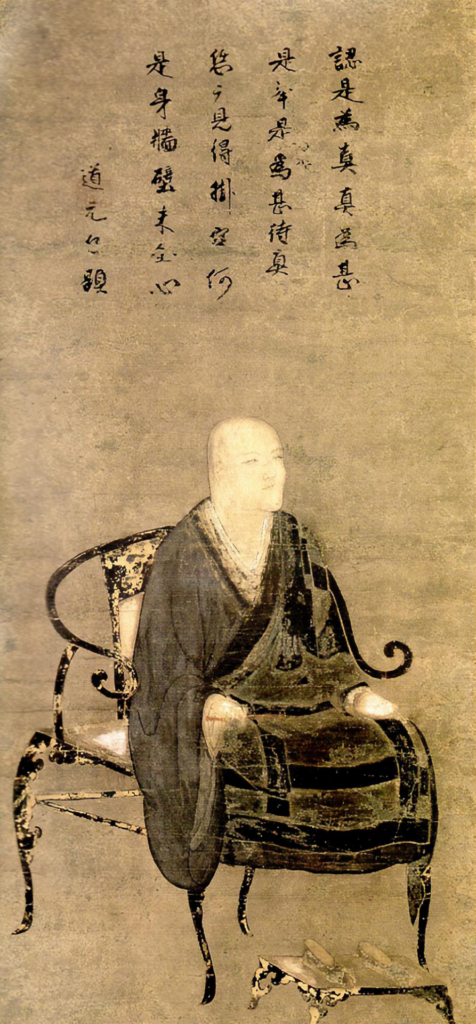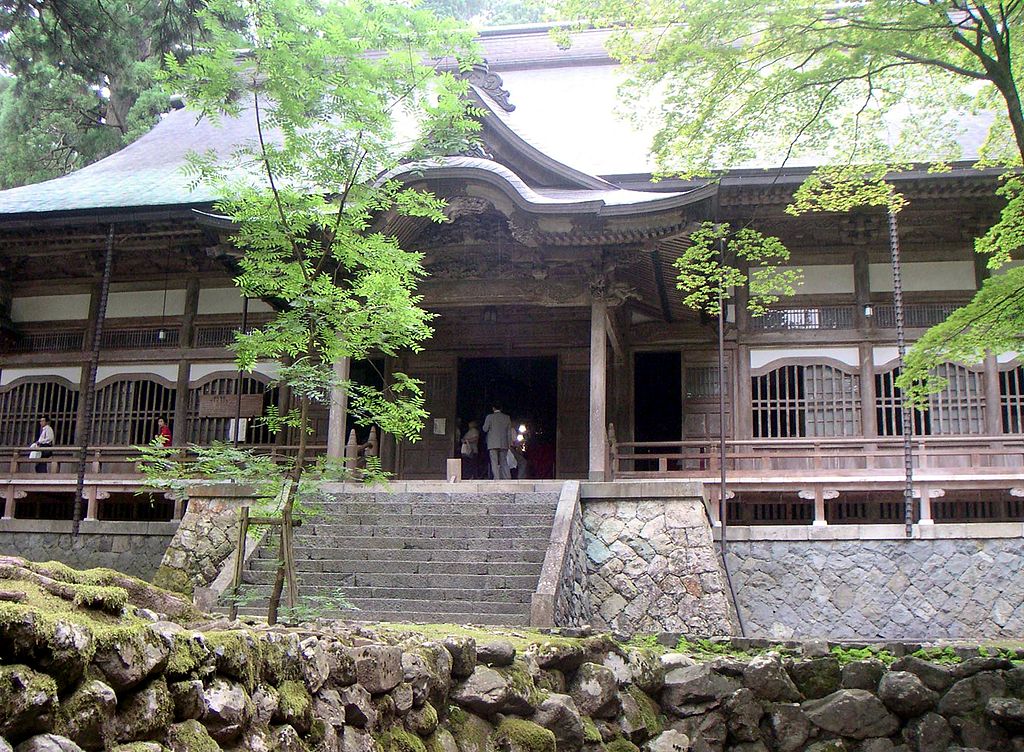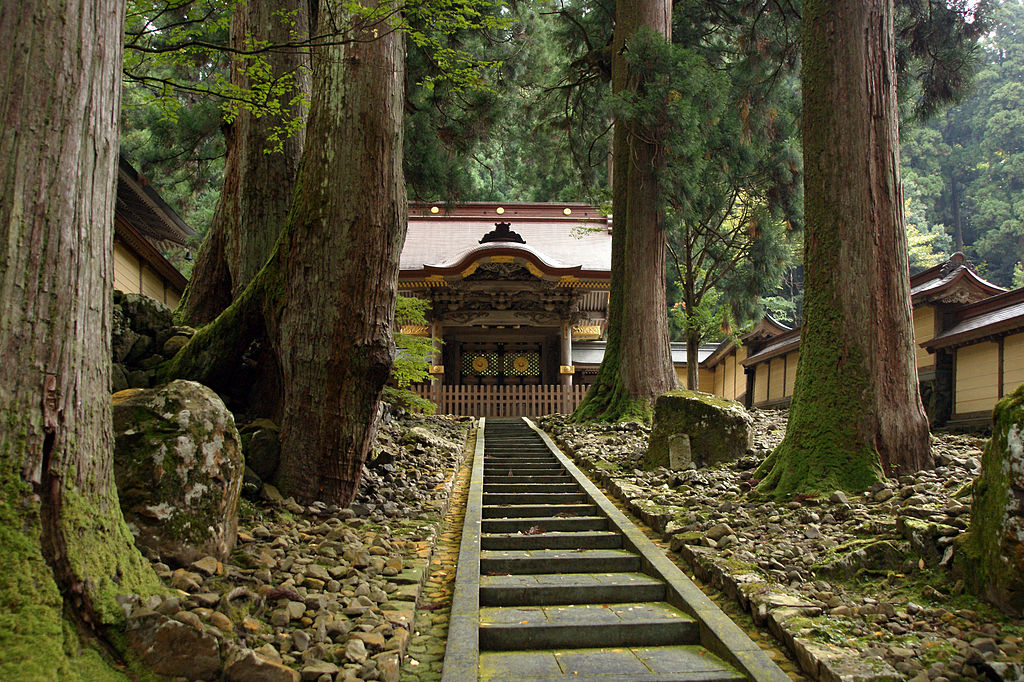
In 1230, soon after leaving Kenninji to move into an abandoned temple in Fukakusa, Dogen begun the composition of Shobogenzo (Treasury of the True Dharma Eye) with the chapter on Bendowa. By 1233, the year when he wrote the Genjokoan, Dogen had already moved again, and settled at the Kannon-doriin temple, also in Fukakusa, which he soon expanded into the Kosho-horinji temple. Genjokoan is now the very first fascicle of the Shobogenzo, and is regarded as a gateway to the whole text. Shohaku Okumura has written a brilliant presentation of the Genjokoan, which I will use as my main source.
Genjokoan is a short text, five pages in Okumura’s book, but it is a text most of us could not fully understand without a guide. Just the title, which is a word which Dogen coined, needs to be unpacked. Okumura explains that “Gen” means “to appear,” “to show up” or “to be in the present moment.” It can also be a noun for something unseen that now can be seen … for instance the moon appearing from behind the clouds or a person appearing from within a house. Also “genzai” in Japanese means “present moment” and “gendai” means “modern times.” So “gen” can be a kind of manifestation or actualization of something potential into something actual. “Jo” means “to become,” “to complete,” or “to accomplish.” As a verb the compound term “genjo” means “to manifest,” “to actualize” or “to appear and become.” As a noun it refers to reality as it is actually happening in the present moment.”
“Koan,” in the second part of the title, has become a familiar word for most people. It is often described as a question and answer “riddle” to help practitioners grasp the apparently paradoxical nature of reality. In fact, having originated from exchanges between master and disciple in ancient China, koans were considered to be expressions of the truth. Okumura explains that the word “koan” was derived from the Chinese word “gong’an” used for “a public document placed on the desk of a government office, and in ancient China it referred to a law issued by the emperor. Such a law was unchangeable and unquestionable, applying to all the nation’s subjects.” Likewise, the stories told in the koans were “an expression of unchangeable truth.” Included in “gong’an” as an official document was the connotation of “public” and with it, that of “equalizing inequality … To make something public meant to make something equal.” On the basis of this etymology, Genjokoan refers to the “real-isation” or “actualisation” of ultimate reality, as arising from our original enlightenment, moment by moment, in our lives. The addition of the word “realizing” in the title of Okumura’s book is meant to highlight this fact.
Okumura adds that another etymology for “koan” was proposed by Senne, a close disciple of Dogen who wrote the first commentary on the seventy-five chapter Shobogenzo: “ko” would point to the equality (unity) behind the diversity of the many things we see, whereas “an” would instead points to the particularity (uniqueness) of the things. “Koan” would then mean that “Reality, or emptiness, includes both unity and difference.”
“Genjokoan,” therefore, means, “actualising reality as it is, both unity and difference, the one and the many.” It has been translated by Kazuaki Tanahashi more succinctly as “Actualizing the Fundamental Point.”
As for the title of the Shobogenzo, which Okumura translates as “The Treasury of the True Dharma Eye,” I could add that the “True Dharma Eye” is the eye that can see things as presencing “without verbal identification,” “just as they are,” in their “suchness” or “as-ness,” moment by moment.
I will be following the text of the Genjokoan which Okumura includes in his book. I see that the arrangement of sections is different in Kazuaki Tanahashi’s translation of the text.
The first three sections of Genjokoan are best studied together, as an introduction of the three stages in the way the Dharma was taught by Shakyamuni Buddha (as recorded in the Theravada school), later in the Mahayana sutras, especially the Heart Sutra, and last, in Dogen’s own writings, especially the Shobogenzo. Dogen sums up these three stages in the first three sentences of the Genjokoan. As is immediately apparent, whereas the Mahayana wording appears to contradict that of the Theravada, Dogen’s own articulation of the Dharma, being non-dual, overcomes the apparent contradiction:
(1) When all dharmas are the Buddha Dharma, there is delusion and realization, practice, life and death, buddhas and living beings.
(2) When the ten thousand dharmas are without [fixed] self, there is no delusion and no realization, no buddhas and no living beings, no birth and no death.
(3) Since the Buddha Way by nature goes beyond [the dichotomy of] abundance and deficiency, there is arising and perishing, delusion and realization, living beings and buddhas.
The first sentence – “When all dharmas are the Buddha Dharma, there is delusion and realization, practice, life and death, buddhas and living beings” – reflects the view of ordinary everyday consciousness, where all things are seen from the outside as discrete entities interacting according to the law of cause and effect. This is the way Sakyamuni presented his teachings of the Twelve Links of Causation, the Four Noble Truths, etc. Okumura talks about the latter as found in the teaching of the Four Seals. “The first of the four seals says that everything in this life contains suffering. The second says that everything is impermanent. The third says that everything lacks independent existence or fixed self, and the fourth says that nirvana is tranquility … The message is that we can live our lives in one of two ways: we can live within samsara (the first seal) or within nirvana (the fourth seal). Whether we live within samsara or nirvana depends upon whether or not we awaken to the reality of impermanence (the second seal) and lack of independent existence (the third seal).” The Twelve Links of Causation map out the path one needs to follow in order to disentangle the chain of causes and effects that drives us to our current state of misery. The Noble Eightfold Path describes the Buddhist path as a linear progression: first you establish a moral life (sila), and then you sit and concentrate (samadhi). This should allow you to develop wisdom (prajna). This is a view that presents delusion as the opposite of realisation, practice as a path from the one to the other, life as different from death, buddhas as different from ordinary human beings.

The second sentence – “When the ten thousand dharmas are without [fixed] self, there is no delusion and no realization, no buddhas and no living beings, no birth and no death” – spells out a radical negation of Sakyamuni’s teachings. It is that which comes out of the series of “noes” in the Heart Sutra – no eye, ear, nose, tongue, body, mind … no consciousness … no suffering, nor annihilation nor an Eightfold Path, no knowledge, no attainment” – if one were to take them literally. The emphasis on negation emerged from the centrality given to Nagarjuna’s teaching about emptiness, which shaped the philosophical views of Madhyamaka, Yogacara, and Tathagata-garbha. They are found in the Prajnaparamita Sutra, the Lotus Sutra, Avatamsaka Sutra, the Pure Land sutras, and others. Okumura explains: “It is very important that we understand what these negations mean. These negations were written to help us realize the freedom that the Buddha taught of: freedom from attachment, in this case attachment to concepts that narrow our ability to respond to reality as it unfolds.”
The third sentence – “Since the Buddha Way by nature goes beyond [the dichotomy of] abundance and deficiency, there is arising and perishing, delusion and realization, living beings and buddhas” conveys the teachings of Dogen.
Shohaku Okumura approaches the explanation of this third section by bringing up a text Dogen wrote just before writing the Genjokoan – the Maka Hannya Haramitsu. This text is a commentary close to the Heart Sutra, whereas in Genjokoan Dogen uses a more poetic language. Okumura notes that “the Heart Sutra said [the] five skandhas are empty, but here Dogen says they are “the fivefold prajna”; they are themselves “prajna paramita,” or wisdom.” Also, in the Maka Hannya Haramitsu, Dogen replaces the Heart Sutra’s well-known formula “form is emptiness, emptiness is form,” by “form is nothing but form, emptiness is nothing but emptiness – one hundred blades of grass, ten thousand things.”
Dogen is here directing our attention to an important point, namely the difference between knowing things through concepts (thinking) and knowing things in their suchness. In Okumura’s words: “Form is emptiness and emptiness is form” is still a product of the process of thinking. This process presents both “form” and “emptiness” as concepts within the mind, and then it says that these two concepts are one thing. But Dogen Zenji points to the reality of form and emptiness within our actual lives, and this reality includes much more than just mental processes or conceptual views. Each one of the myriad things is a form. All things are themselves empty, and yet when we say “all things are themselves empty,” we produce a thought; we connect two concepts.”
Okumura continues: “Dogen cautions us not to live our lives according to our thinking; he admonishes us rather to just see and to just live. To live in this way means that we just see and experience what we encounter in our lives without saying it is empty, even though it truly is empty. That’s it … Dogen placed importance on the true reality of each being rather than on any conceptual reality we might have of it. He saw that true reality does not dwell within our thinking; it is everyone of myriad things.” This is what Dogen means when he says, “‘One hundred blades of grass – ten thousand things’. In other words, everything is prajna paramita because everything is empty. Prajna is not a personal, individual wisdom we can possess; rather, each thing is itself reality and each thing is itself prajna, or wisdom.”
So wherever the Heart Sutra places a “no” before the name of something to say that it does not exist, Dogen says that “these things are in fact prajna exactly because they ‘are’ empty.” Therefore, rather than negating things in thought, we should “actively encounter everything in our lives as prajna.” Such an action, in contrast to a thought, “actualises” prajna paramita in our lives.
Okumura writes: “This actualization is the actualization of Buddha’s Dharma body, or reality itself. The word “actualizing” here is a translation of genjo, and we can therefore see a close connection between Maka Hannya Haramitsu and Genjokoan. Genjokoan (to actualize koan) is equivalent to actualizing (practicing and manifesting) prajna paramita.” This entails that “since everything is prajna paramita, we should inquire into everything. ‘To inquire into everything’ means to try to see the reality of each and every being. In other words, prajna paramita is reality itself … we must inquire into the nature of reality and practice with it.”
At this point, Okumura points out that, although teaching implies the use of words, he would like to warn us that we should not take his words on trust. He says, “If I mistakenly cling to my egocentric ideas and write about my understanding only in order to convince others of my views, I am not expressing prajna … You must be really free from what I say and you must inquire into prajna and practice prajna yourself.”
Returning to the Genjokoan, Okumura is now ready to explain the third section, which represents Dogen’s own way of teaching.
“Since the Buddha Way by nature goes beyond [the dichotomy of] abundance and deficiency, there is arising and perishing, delusion and realization, living beings and buddhas.”
In Dogen’s teaching, there is a reaffirmation of “things/events” in their individuality, at first sight similar to that found in Sakyamuni’s teachings as presented in Theravada texts. Yet, this affirmation is different. It is no longer a conceptual assertion reflecting the mode of thinking of ordinary consciousness. Things/events are reaffirmed as “empty” and, as such, the expression of prajna, arising out of reality just as it is. No longer is prajna the outcome of a linear path starting with moral life and deepened by samadhi. For Dogen, prajna arises from reality itself, empty and mutually encompassing. In other words, we don’t practice “in order to” become buddhas, we practice “because” we are buddhas. Practice is not a technique to gain enlightenment. It is the expression or actualisation of our original enlightenment.
Okumura explains that abundance stands for something positive, and deficiency for something negative. In Buddhism, it translates as trying to escape samsara in order to enter nirvana. If, however, “we simply …devote our lives to the practice of eliminating our ignorance and egocentric desires, we will find that it’s impossible to do. Not only is it impossible, but it actually creates another cycle of samsara. This happens because the desire to become free from delusion or egocentricity is one of the causes of our delusion and egocentricity. And the idea that there is nirvana or samsara existing separately from each other is a basic dualistic illusion; the desire to escape from this side of existence and enter another side is another expression of egocentric desire.”
Okumura continues: “When we are truly in nirvana we awaken to the fact that nirvana and samsara are not two separate things … [The] desire to end our suffering is another cause of suffering, and the Heart Sutra presents the Buddha’s teachings in a negative way in order to avoid arousing this desire.” But, again, if samsara and nirvana are one, why do we have to practice? It was the haunting question that prompted Dogen to leave both Mt Hiei and Kenninji, and go to China. “Dogen’s answer to this question was “just practice”; not because we want to escape from samsara, not because we want to reach nirvana, but just practice right now, right here ‘without any agenda’ … In Japanese the expression shikan (as in shikantaza – “just sitting”) means “just do it,” without the thought ‘I don’t like samsara so I’m practicing to reach nirvana in the future.’ Such goal-oriented thinking is just a story we create … When we just open the hand of thought and face whatever we are facing, we can truly find peace. We don’t need to … go somewhere else; we just live right now, right here, with mindfulness. This is how we can find a way to live in nirvana within samsara.”
Source:
Shohaku Okumura – Realizing Genjokoan

